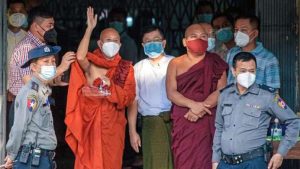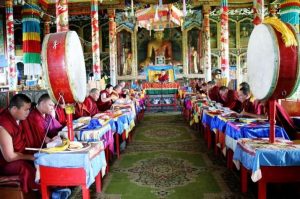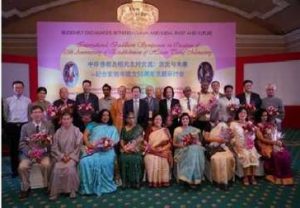
Khenchen Pema Sherab Rinpoche, one of the most respected teachers of the Nyingma school of Tibetan Buddhism and a senior khenchen* of Namdroling Monastery in southern India, made his first visit to Bulgaria in September.
The visit came at the invitation of Palyul Center Bulgaria and its founder, Khen Rinpoche Pema Chophel (Pema Rinpoche). Accompanying Khenchen Rinpoche were his translator the renowned scholar Khenpo Sonam Tsewang, and Rinpoche’s attendant, Ani Pema. Together, they participated in a week-long program, joined by Pema Rinpoche and Khenpo Dawa, resident teacher at Palyul Center Germany.
The program began on 13 September with a ceremony on the occasion of Guru Rinpoche Day, led by Khenpo Dawa. This was followed by a gathering of the Bulgarian Palyul Sangha with their main teacher, Pema Rinpoche, at Palyul Center in Sofia.

On 14 September, Khenchen Rinpoche delivered a lecture, “How to Turn Adversity into Our Allies,” based on the mind-training text Eight Verses of Training the Mind (Tib. lojong tshig gye ma zhugs so) by Geshe Langri Thangpa (1054–1123). On 15 September, the esteemed Palyul teacher bestowed a Green Tara empowerment (Tib. doljan wang) from The Profound Essence of Tara (Tib. zabtig drolchog), a popular practice revealed as a mind terma by Chokgyur Dechen Lingpa (1829–70). Both events attracted more than 200 people and generated significant interest among Buddhist and non-Buddhist attendees.
The program continued at Palul Center Bulgaria on 16 September, when Khenpo Sonam Tsewang gave a teaching on the Four Noble Truths (Tib. phagpe denpa shi). On 17–19 September, Khenchen Rinpoche taught from the text The Casket of Siddhis: A Recitation Manual for the Vidyadhara Assembly, related to the practice of Rigdzin Dupa (The Vidyadhara Assembly), the inner lama practice from the Nyingma cycle Longchen Nyngtik, the terma revelation of Rigdzin Jigme Lingpa (1730–98).
During his stay in Bulgaria, Khenchen Rinpoche kindly agreed to speak with BDG.
BDG: How is Buddhism changing and adapting to our globalized world?
Khenchen Pema Sherab Rinpoche: When the Buddha gave his teachings, the main purpose was to bring mind-transformation. When it comes to mind-transformation, it matters how you present the teaching according to the present context and modern sensibilities. The teachings themselves remain unchangeable, but how they are presented may change. This is how it is and how it should be.
Historically, when we look back at how the teachings evolved, we see that, according to the Nyingma tradition, the Buddha’s teachings are divided into nine vehicles (Tib. tekpa gu). The first three vehicles are the vehicles of renunciation, where the teachings of the shravakas, pratyekabuddhas, and bodhisattvas are taught. Then, we have the three outer tantras (kriya, charya, and yoga), and above these are the three inner tantras (mahayoga, anuyoga, and atiyoga). These three levels of teachings are provided based on the interests, faculties, and different capacities of beings.
As we move into the 21st century, people’s responses, their thought processes, and the way the Buddha’s teachings are presented have changed, although the core essence remains intact. How we present the teachings should change because that is how people, their value systems, and everything change. Based on this, the Buddhist teachings should be presented that way, otherwise they risk becoming irrelevant.

BDG: In the wake of the COVID-19 pandemic and global conflicts, people are increasingly suffering from anxiety, depression, and panic disorders. How can the Buddhadharma help to calm their minds?
KPSR: One of the foundational Buddhist teachings is to train our mind to become familiar with the nature of samsara and why we are here. Is this cyclic existence, the world we are living in, inherently a happy place or not? This contemplation is considered to be so important in Buddhist practice. Where it can actually help us is so that we are not unrealistic about what is happening and what is bound to happen.
When we train our mind in the nature of samsara, what actually helps us is accepting whatever is happening around us. This is the difficult part. When we are not trained in this, then we feel shocked if some tragedy occurs. It can be anything from an epidemic or a war to a personal loss. Everybody, individually or collectively, goes through certain things that we normally consider as something impossible, and we ask ourselves: how could this happen to me? How could this happen to humanity? These kinds of shocking experiences happen because we are not trained in the reality of what constitutes samsara. Because of this, we think that whatever is happening couldn’t possibly to happen to us as an individual or as a group. And that leads to lot of fear, anxiety, stress, and whatever you may call it.
This is why in Buddhist training, meditation and contemplation on the nature of samsara is a very foundational practice to train our mind. It helps to provide space in our heart and mind for the reality that any tragedy can happen at any moment of our lives. Therefore, we are always ready. When we are ready, then we are not shocked, because acceptance is there.
And why there is so much fear? It’s because we don’t have that space in our hearts to accept reality. This is why Buddhist training can really help—regardless of whether people are Buddhists or not—train our mind in the nature of samsara: how the nature of samsara is transient, always changing, not staying in one place, and how samsara is a very insecure place. Why is it unrealistic to find security in samsara? How much can we expect from samsara? All of these are important questions in Buddhist practice and can really help people, whether or not they are Buddhists.
To have the capacity to accept the truth, the reality of the situation, and move forward, to see that this existence that we have is not permanent but is subject to change: every aspect of our life is bound to change at any moment. When we develop that space in our heart, then nothing will be shocking. In that respect, training our mind in the ephemeral, ever-changing nature of things is essential. Whether it is our body or mind, the people that surround us, the society or world in which we are living, all of these aspects are conditions and are subject to change. When we are not ready to accept that change, that brings us a lot of pain.

BDG: Do you see any dangers from the increasing use of AI? How can we preserve human values in the age of technology?
KPSR: From a Buddhistic perspective . . . the danger is actually how human beings look at AI, how they perceive and use AI. At the end of the day, AI is created by the humans. Therefore, humans should be wise enough to use this technology in an intelligent, constructive, and positive way. Otherwise, there will certainly be dangers for humanity. If humans are careful in dealing with it, then it can be controlled.
At the end of the day, AI itself is created and monitored by humans. How it is created and how we use it depends on our intelligence. Therefore, we should use our wisdom and use AI constructively to bring about positive change. Otherwise, it can be destructive, just as human intelligence can be destructive. . . . Definitely humans bear responsibility in terms of controlling and checking the quality of AI and how it is used—effectively or not, constructively or not.
This kind of discriminative awareness, this wisdom is something that we need to develop because this is a kind of new reality in today’s world. Sometimes, when we are so fascinated with AI, it does even more than humans do. Sometimes it feels as though AI has ultimate potential, but it does not have the ultimate potential of becoming awakened, to be free from all suffering, to develop compassion, love, all these human values, which are very much needed for the survival of the human species. This is something that AI can’t do. We humans have that potential and we don’t need to fear that our capacity, our potential will be washed away. Not at all.
Everything depends on our discriminative awareness of what is right and what is wrong, of what is positive and what is negative, of what is good in the long term and what is harmful in the long run. The human mind and intelligence have that kind of deferential factor and potential.
In Buddhism, we say that if one can practice wholeheartedly, using one’s own intelligence, relying on an authentic master, then one can attain awakening in one lifetime. This is part of human intelligence. On the other hand, if that intelligence is used in a negative way, with destructive purpose, then it can destroy everything, the whole planet—just as the nuclear bomb was also created by human intelligence. Therefore, AI has the capacity to be constructive and destructive at the same time. Therefore, making the right choices—using intelligence in a positive way so that it brings happiness to oneself and to others—all depends on human intelligence.
BDG: Khenchen Rinpoche, thank you very much for sharing your wisdom with us.

Khenchen Pema Sherab Rinpoche was born at Riphu in the traditional Tibetan region of Kham in 1936. In 1953, Shechen Kongtrul Rinpoche (1901–59) bestowed novice vows upon him. In 1959, he fled to India, where he met Dilgo Khyentse Rinpoche (1910–91), from whom he received most of his teachings. On various occasions, Khenchen Rinpoche received many teachings and oral transmission from Dudjom Rinpoche (1904–87) and Penor Rinpoche (1932–2009). In 1968, Penor Rinpoche invited Khenchen Rinpoche to Namdroling to teach the Dharma. Since the establishment of the Ngagyur Nyingma Institute in 1978, Khenchen Rinpoche has been teaching out of great compassion and kindness. He has traveled extensively in India, Nepal, and Europe, visiting many Dharma centers and sharing Buddhist wisdom with thousands of practitioners.
* A title of special distinction bestowed on highly respected khenpos.
See more
Palyul Ling International
Palyul Cennter Bulgaria
Related news reports from BDG
Festival of Tibetan Culture Marks the Dalai Lama’s 89th Birthday in Bulgaria
Bulgaria’s Sofia University to Launch Master’s Program in Buddhist Studies
Tibetan Bon Teacher Geshe Lhundup Gives Dzogchen Teachings in Bulgaria















